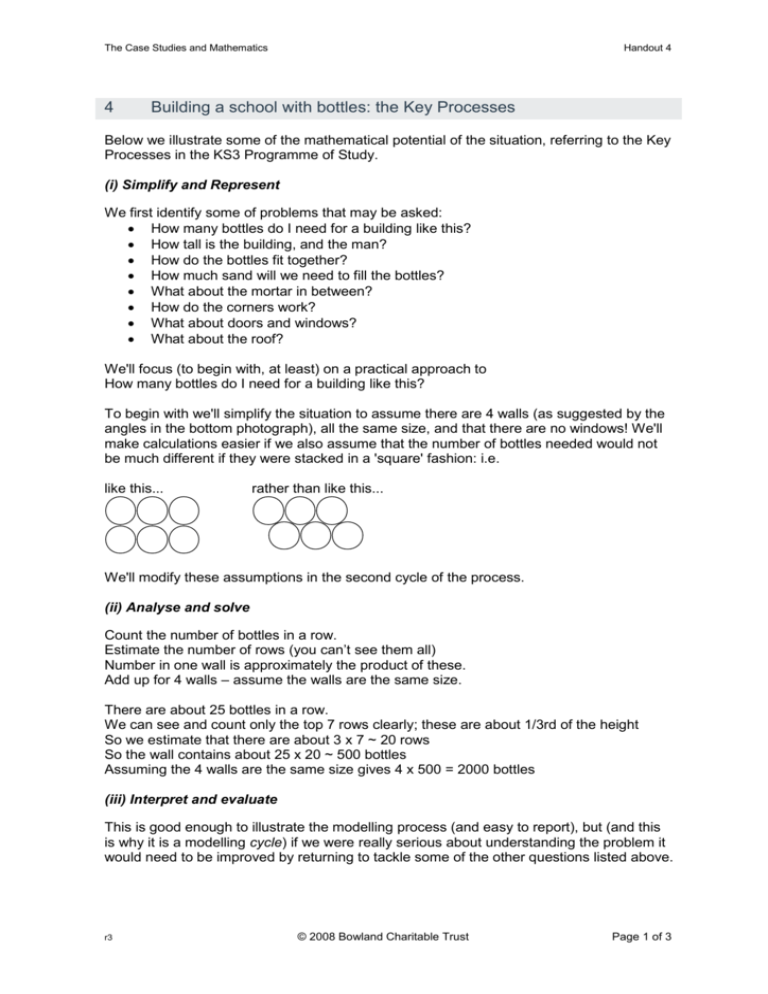DOC - Bowland Maths
advertisement

The Case Studies and Mathematics 4 Handout 4 Building a school with bottles: the Key Processes Below we illustrate some of the mathematical potential of the situation, referring to the Key Processes in the KS3 Programme of Study. (i) Simplify and Represent We first identify some of problems that may be asked: How many bottles do I need for a building like this? How tall is the building, and the man? How do the bottles fit together? How much sand will we need to fill the bottles? What about the mortar in between? How do the corners work? What about doors and windows? What about the roof? We'll focus (to begin with, at least) on a practical approach to How many bottles do I need for a building like this? To begin with we'll simplify the situation to assume there are 4 walls (as suggested by the angles in the bottom photograph), all the same size, and that there are no windows! We'll make calculations easier if we also assume that the number of bottles needed would not be much different if they were stacked in a 'square' fashion: i.e. like this... rather than like this... We'll modify these assumptions in the second cycle of the process. (ii) Analyse and solve Count the number of bottles in a row. Estimate the number of rows (you can’t see them all) Number in one wall is approximately the product of these. Add up for 4 walls – assume the walls are the same size. There are about 25 bottles in a row. We can see and count only the top 7 rows clearly; these are about 1/3rd of the height So we estimate that there are about 3 x 7 ~ 20 rows So the wall contains about 25 x 20 ~ 500 bottles Assuming the 4 walls are the same size gives 4 x 500 = 2000 bottles (iii) Interpret and evaluate This is good enough to illustrate the modelling process (and easy to report), but (and this is why it is a modelling cycle) if we were really serious about understanding the problem it would need to be improved by returning to tackle some of the other questions listed above. r3 © 2008 Bowland Charitable Trust Page 1 of 3 The Case Studies and Mathematics Handout 4 Possible refinements include, for example: What size bottles are these? (We could estimate from the height of the man) How much sand would we need? (E.g., 2000 one-litre bottles need 2-3 tonnes; why? ) …. and, of course, we would need to make a proper plan for the building (i) Simplify and represent We could represent the stacking of the bottles in other ways, for example by closer packing like figure A (assuming no mortar) or figure B (with some mortar). No mortar: Some mortar between rows: (ii) Analyse and solve If there was no mortar, the length of the longest row would be equal to the diameter of bottle x number of bottles in a row. The height between rows would be the height of the equilateral triangle in the figure. This might be calculated either by Pythagoras or simply by measuring a model made from three bottles! Height between rows = 3 diameter 0.87 diameter 2 So the saving in gaps from close packing (compared with square stacking) would be about 13% although there are bigger gaps at the ends of each row. height between rows appears to be approximately equal to the diameter With mortar, the of each bottle. Thus we can reasonable assume that the height of a wall is approximately equal to the diameter of bottle x number of rows of bottles. Both models reduce the number of bottles needed by only one for every two rows. The number of bottles needed for each wall may be counted and represented in a table: Number of rows of bottles (r) 5 rows 3 bottles 6 5 4 3 2 1 9 15 21 27 33 8 13 18 23 28 6 10 14 18 22 5 8 11 14 17 3 5 7 9 11 2 3 4 5 6 2 3 4 5 6 Number of bottles in longest row (n) 39 33 26 20 13 7 7 If we assume (as before) that there are 25 bottles in the longest row and 20 rows, then this arrangement would require just 10 fewer bottles, or 490 bottles for each wall. For 4 walls this gives 1960 bottles - only 2% fewer than our previous estimate! r3 © 2008 Bowland Charitable Trust Page 2 of 3 The Case Studies and Mathematics Handout 4 (iii) Interpret and evaluate This analysis confirms our earlier one as being very reasonable. The following analysis is algebraic, an approach that reveals the general structure of the problem. This will be beyond the capabilities of many pupils, but it illustrates here the process of analytic modelling in a simple situation. (i) Simplify and represent How many bottles do I need to build any rectangular building of bottles? First select and list the variables: Height of wall h Width of wall w Diameter of a bottle d Number in row n Number of rows r Number in wall W Total number of bottles T We will also denote each wall by subscripts 1 to 4. Now we generate relationships between the variables: T W1 W2 W3 W4 (Total number of bottles in all 4 walls) W1 n r etc. (Assume all walls have same height, thus same r) h d w n1 1 etc. d r (Assume rows are d apart) (Not assuming each wall is same width) (ii) Analyse and solve We can form some new equations by combining these: h w1 h d d d2 h T (w1 w 2 w 3 w 4 ) 2 d h T P 2 (where P Total perimeter of house) d A T 2 (where A Total area of the walls) d W1 n r w1 (iii) Interpret and evaluate We can get estimates for the number of bottles needed from either of these two last equations. The final one also doesn't assume that there are no doors and windows. It simply states that each bottle occupies a wall area equal to the square of its diameter. Perhaps we should have seen this simple relationship at the outset! r3 © 2008 Bowland Charitable Trust Page 3 of 3









